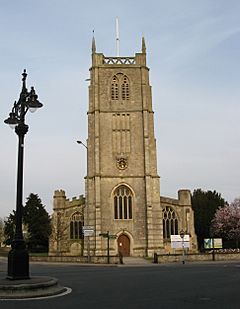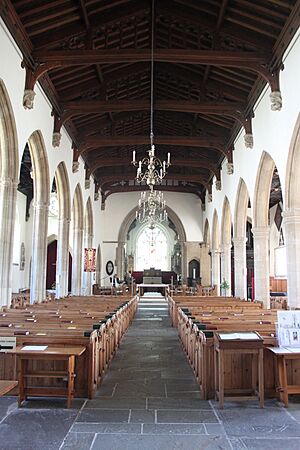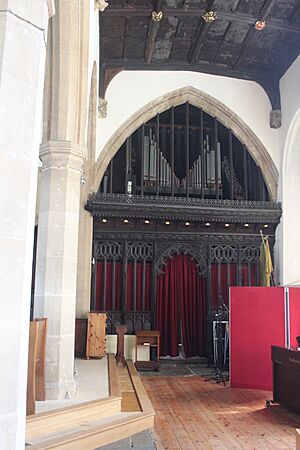Church of St John the Baptist, Keynsham facts for kids
Quick facts for kids Church of St John the Baptist |
|
|---|---|
 |
|
| Location | Keynsham Somerset, England |
| Built | c. 1270 |
|
Listed Building – Grade II*
|
|
| Designated | 27 February 1950 |
| Reference no. | 1384628 |
| Lua error in Module:Location_map at line 420: attempt to index field 'wikibase' (a nil value). | |
The Church of St John the Baptist is an old church in Keynsham, England. It was built around the year 1270. This church is very important, so it's called a Grade II* listed building. This means it's a special historic place.
For a long time, the church was connected to Keynsham Abbey. But the Abbey closed down in 1539. In 1632, a tall part of the church called a spire fell down. A new bell tower was then built. Since then, the church has been repaired and updated many times. It has also helped with charity work both locally and around the world.
Inside the stone church, you can see old things like the pulpit, the font, and shiny brass chandeliers. The church's organ has been changed and moved since it was first put in back in 1847. There's a fun story that a famous musician, George Frideric Handel, traded two bells for an older organ from this church. However, no one knows for sure if this story is true. The bells in the tower are very old, some from the 1500s, 1600s, and 1700s.
Contents
A Look at the Church's History
Keynsham had a church as early as the 800s. In the 1100s, Keynsham Abbey was built. It was the main place of worship for the town. Around 1270, a new church was built just for the people of Keynsham. The Abbey was in charge of the chancel (the area around the altar), and the town looked after the rest of the church.
The Abbey and the town didn't always get along. This continued until the Abbey closed in 1539. The south side of the church and the south entrance were added around 1390. The chancel was rebuilt in 1470. After the Abbey closed, a man named Sir Henry Bridges bought the Abbey's land in 1552. His family then had a say in who became the church's vicar for many years.
How the Church Changed Over Time
The Church of St John the Baptist slowly changed into the building we see today. A big storm in 1632 caused the spire over the north side to fall into the church. After this, a new tower was built. This tower stands tall at the western entrance. It has three levels and a fancy top with small spires. People say parts of the old Abbey were used to build this new tower.
More repairs were done between 1634 and 1655. This included adding a new pulpit. After the English Civil War in the 1640s, the vicar, Thomas Codrington, got more money. This was part of a deal made with the local lord, Thomas Bridges, who had supported the king. When the king returned to power, Codrington seemed to change his mind. He then treated the local quakers badly, who had supported the other side.
In the 1700s and early 1800s, fewer people came to church. The building also started to fall apart. By 1843, the south entrance was being used to store coal, and the roof was leaking. In the 1850s, George Robinson became the new vicar. He brought the church back to life. He rebuilt his house for his 13 children and started a church school. He also raised money to fix the church building.
This work included removing old box-shaped pews, fixing the windows, and rebuilding the arches inside. Gas lights were put in, the roof was repaired, and the walls were replastered. All this cost about £4,000. Much of the repair work was done by Benjamin Ferrey between 1861 and 1863. As the building was fixed, more church services were held, and more people came. Robinson left in 1870. Joseph Gray took over and continued to improve the church and its charity work. He helped local people and missionaries around the world. During his time, the churchyard became full, so a new cemetery was started.
The Church in Modern Times
In the 1900s, Keynsham's population grew. This was partly because the Somerdale Factory was built. Douglas Percival Hatchard became the vicar in 1901. He continued to work on the church school and raised money for more church repairs. The Keynsham Electric Light Company provided heating from their nearby power plant. After World War I, a memorial was built.
During World War II, Vernon Graham Havergal Shaw was the vicar. He believed in peace, which caused some arguments with church members. They wanted prayers for the soldiers, but the vicar disagreed. He left in 1945. Trevor Wright took over. In the 1950s, more problems were found in the church. The wooden parts were damaged by beetles and rot. Repairs cost over £15,000.
Mervyn Wedgewood became the vicar in 1956 as the town continued to grow. He started new groups for the community and helped build a new church called St Francis. The old church rooms were torn down in the 1960s to make way for a new road. The money from this was used to build a new church hall and vicarage. In the 1970s, a team of ministers started working together at the church.
Church Architecture
The church has a long main area called a nave with aisles on both the north and south sides. It also has a south entrance and a small room on the southeast side. The west tower has three levels and is supported by strong walls called buttresses. The roofs inside are made with a special design called Hammerbeam roofs. The church also has beautiful stained glass windows from the 1800s.
Inside the Church: Fixtures
The pulpit where the sermon is given dates back to 1634. There is also a screen from the same time that separates the choir area. The small font at the front of the church was given by Harry Bridges in 1725. Three shiny brass chandeliers hang in the nave. They were given by Mrs Ann Tilly in 1717.
The Church Organ
The first time we know for sure that the church had a pipe organ was in 1847. A new organ with two keyboards and 14 stops was put in by George Sherborne. In the 1860s, it was moved to the east end of the south aisle. Then, in the 1880s, it was made bigger. The part where the organist sits was moved to the chancel, and the pipes were placed behind a screen. A clarinet sound was added in the 1920s, and an electric blower was put in in 1939. The organ had a big repair in the 1960s, with more work done in 1986, 1991, and 2000.
There's a story about an older organ that was once in the church. People said it had such a beautiful sound that George Frideric Handel wanted it. Around 1730, he supposedly offered a set of bells in exchange for the organ. The church accepted the offer. Handel took the organ, and the bells were delivered.
The Church Bells
Five of the eight church bells in the bell tower are still around from when the spire fell in 1632. The oldest bell we know about for sure is the Great Bell, which was paid for by Nicholas St Loe in 1508. The Sanctus Bell from 1531 hangs in the bell tower but is not part of the main set of ringing bells. The seventh bell we have today is from 1602, the sixth from 1607, and the fourth from 1613. The third bell was added around 1654, after the tower was finished.
In 1731, the Bilbie family from Chew Stoke made two more bells. The smallest bell has these lines written on it:
"I value not who doth me see
For Thomas Bilbie casted me;
Althow my sound it is but small
I can be heard amongst you all."
In 1987, all the bells were taken down from the tower. They were reshaped by White's of Appleton and then carefully tuned by the Whitechapel Bell Foundry.
The Church Community
St. John the Baptist church is one of five churches in the Church of England Parish of Keynsham. The others are St. Michael's in Burnett, St. Margaret's in Queen Charlton, the "Mission Church" in Chewton Keynsham, and St. Francis' Church. St. Francis' Church was updated between 2013 and 2015 and has two halls for community groups.
The group of churches in Keynsham is part of the larger area called the archdeaconry of Bath.
See also
- List of ecclesiastical parishes in the Diocese of Bath and Wells




